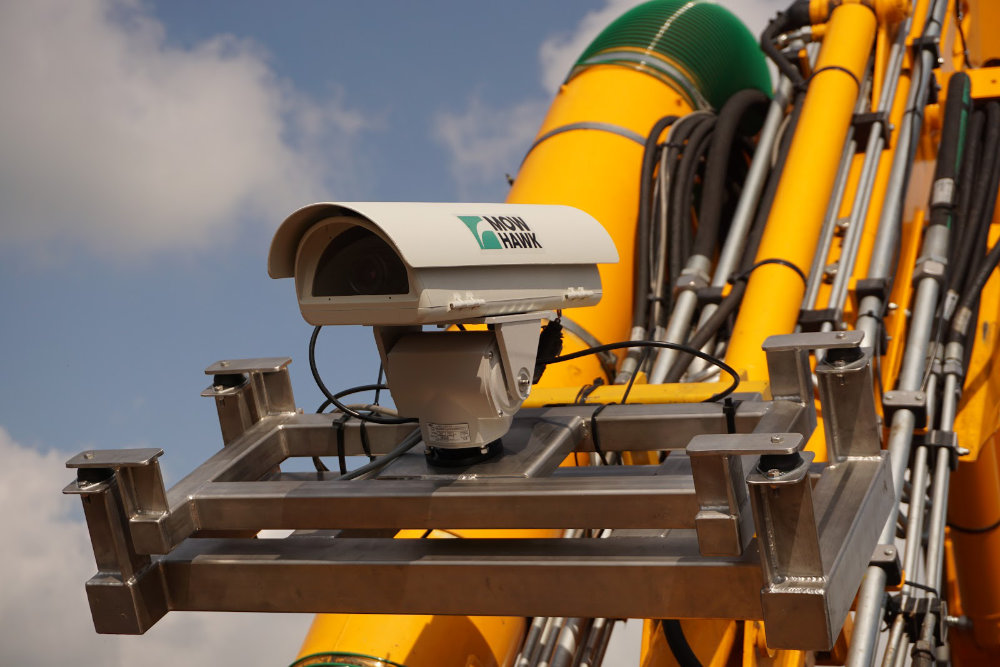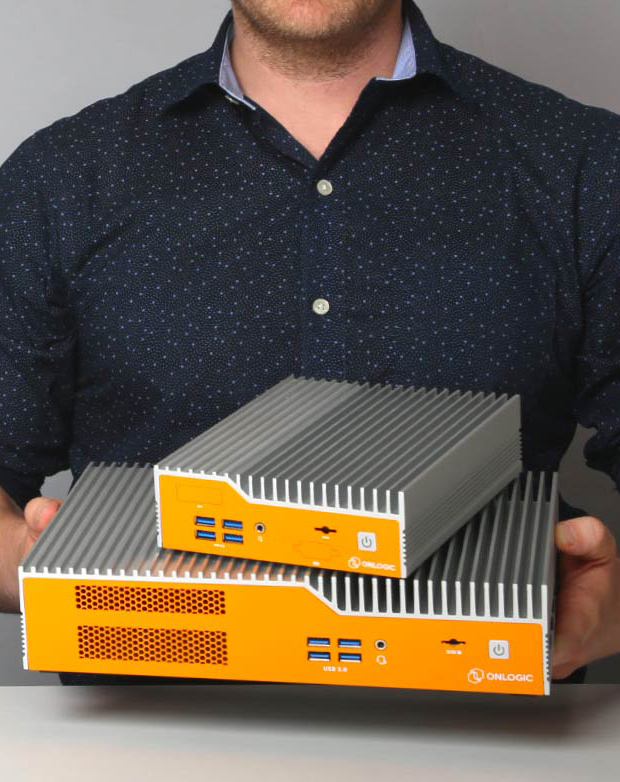AI at the Edge
Recently we recorded Hans Pfisterer, Director of Project Management and Michael Kleiner, VP of Engineering discussing the power of our new Karbon 800 Series for artificial intelligence (AI) at the edge applications. The event was recorded in German and available on YouTube – we’ve provided a recap below.
Here at OnLogic, we are continuously working on new products that can keep pace with growing technological capabilities. For example, systems for the edge and AI at the edge applications are in increasing demand. This means that data processing is increasingly decentralized, at the edge, directly at the point of data acquisition.
Why do decisions need to be made at the edge?
With centralized data processing, the data is first sent to a data center or the cloud and is then processed there. However, this is resource intensive, takes a long time, and cloud computing can be very expensive. For advanced industrial computing, the response time is also far too slow. It often comes down to response times needed at a fraction of a second.
Quality inspection at the edge
One of many examples of decision-making at the edge is quality inspection of manufactured components. Within a very short time, a decision has to be made on-site, based on images recorded by a camera. Did the component pass the quality inspection and will it be processed further or does it have to be disposed of or reworked?
The combination of data at the edge
This process can be further extended by including additional data. The data can originate from a computer, from a PLC (programmable logic controller) or sensors. This optimizes the basis for decision-making. The reason why a component is bad can then be determined. For example, maybe the temperature of the extruder was too high. Then, further measures to correct the flaw can also be identified and initiated immediately. This is just one of many examples for the growing need for edge computing solutions.
What are the challenges at the edge?
Internet access
The edge can be anywhere, even in off-site locations that are controlled remotely, at outdoor locations or right at production facilities. Internet connections are not always available or have low bandwidth. Therefore, the edge computing system needs to have functionality to address these challenges. This could include the ability to process the data and send a limited subset or 4G connectivity to use as back up when the Internet goes down.
Temperature
Another challenging factor is temperature. Edge computers are also used in places that can be very hot or very cold. For the manufacturing industry, heat is part of everyday life on production lines. Wherever refrigerated goods are processed and stored, freezer rooms come into play that need to maintain a constantly cool temperature. Edge systems installed there have to be able to withstand extreme temperatures or temperature variability. That can include daily variability. For example, a computer system used in vehicles might be exposed to wide temperature variability daily.
Power
The power supply at the edge may also present some difficulties for edge computers. They must be able to compensate for power surges without suffering a direct breakdown and bringing the entire production line down.
The K800 –created for the edge
An edge computer must be able to withstand some rigors. That’s why we at OnLogic strive to engineer our products to withstand the conditions of edge applications and the increasing use of AI at the edge. To achieve this, we also take into account feedback from our customers.
As a result, the new Karbon 800 Series have become our most powerful rugged computers.
Features
The Karbon 800 series is based on 12th generation Intel processors. Our hardshell fanless technology enables the Karbon 800 to be cooled without a fan. For heat dissipation, we use cooling fins. In addition, this rugged industrial PC has been tested for its resistance to shock and vibration.
Potential fields of application for the Rugged Edge Computer K800
The Karbon 800 is versatile and really deserves its label “rugged PC”. It can be used on ships, in freight containers, on machines or in dusty production halls and warehouses. Two of the models, the K801 and K802, don’t have a fan that can get clogged by dust. The K803 and K804 feature fanless hybrid cooling.
We offer four K800 models
The Karbon 800 series of rugged PCs includes four models. They have the following special features:
- K801: It is compact and therefore fits into the smallest spaces.
- K802: This model has several expansion slots like ModBay or I/O expansion.
- K803: Among other features, this model shines with a PCIe Gen 4 x16 expansion.
- K804: It comes with a whole range of features at once. These include up to 22 LAN or 30 USB and the ability to accommodate high powered graphics cards. It is also 4G and 5G capable. This makes it a real powerhouse.
Additional options for customers
There are many potential fields of application for edge computers, and depending on the industry, our customers also require specialized functionalities. That’s why the K800 also has an integrated microcontroller. This allows further control functions to be executed and sensors to be integrated using customized code. Many customers are already making extensive use of this feature.
Another interesting option is the use of an integrated graphics processing unit or iGPU. This means that the function is already integrated in the processor’s silicon. The Intel 12th generation processors offer a high level of performance. Thus, there is no need for additional separate hardware like Google Coral, FPGA or a graphics card. Users can work directly with the iGPU.
Customer example – Artemis Vision
The company, which is headquartered in Denver and has a technical site in Regensburg, has developed the RaPTr logistics solution. It is a scanning system using machine vision to scan barcodes on pallets while they are on the move, making them traceable at any time in the supply chain. This ensures that products arrive efficiently at the right place at the right time. The Helix 500 industrial edge PC handles image processing. It is fanless, making it perfect for a warehouse environment that is often dusty. Read more in our customer story on Artemis Vision.
Datacadabra
Dutch company Datacadabra has developed the MowHawk, an intelligent mowing system for roadsides. The company uses the rugged Karbon 700-SE, which can withstand the vibrations of the mower. Using its computer vision capability, the MowHawk detects invasive plant species or litter on the roadside. This allows these parts of the roadside to be mowed separately and the green waste to be disposed of safely. So the system contributes to a sustainable environment. Read more about how it works in our Datacadabra customer story.
Local sales and support
In addition to our US location, we have a sales and support location in Oosterhout, in the Netherlands. And, we always work closely with our supply chain team in Taiwan who are helping us meet delivery times even with the increasingly difficult supply situation. Feel free to contact our hardware professionals for more information.
Get the Latest Tech Updates
Subscribe to our newsletters to get updates from OnLogic delivered straight to your inbox. News and insights from our team of experts are just a click away. Hit the button to head to our subscription page.
Share
More Articles
OnLogic Industrial Computers
Discover OnLogic's multitude of industrial computers that will help you to advance your IoT project
Learn more at OnLogic.com
OnLogic Industrial PCs: Designed to last. Built to order. Delivered in days. Visit our online store at OnLogic.com








